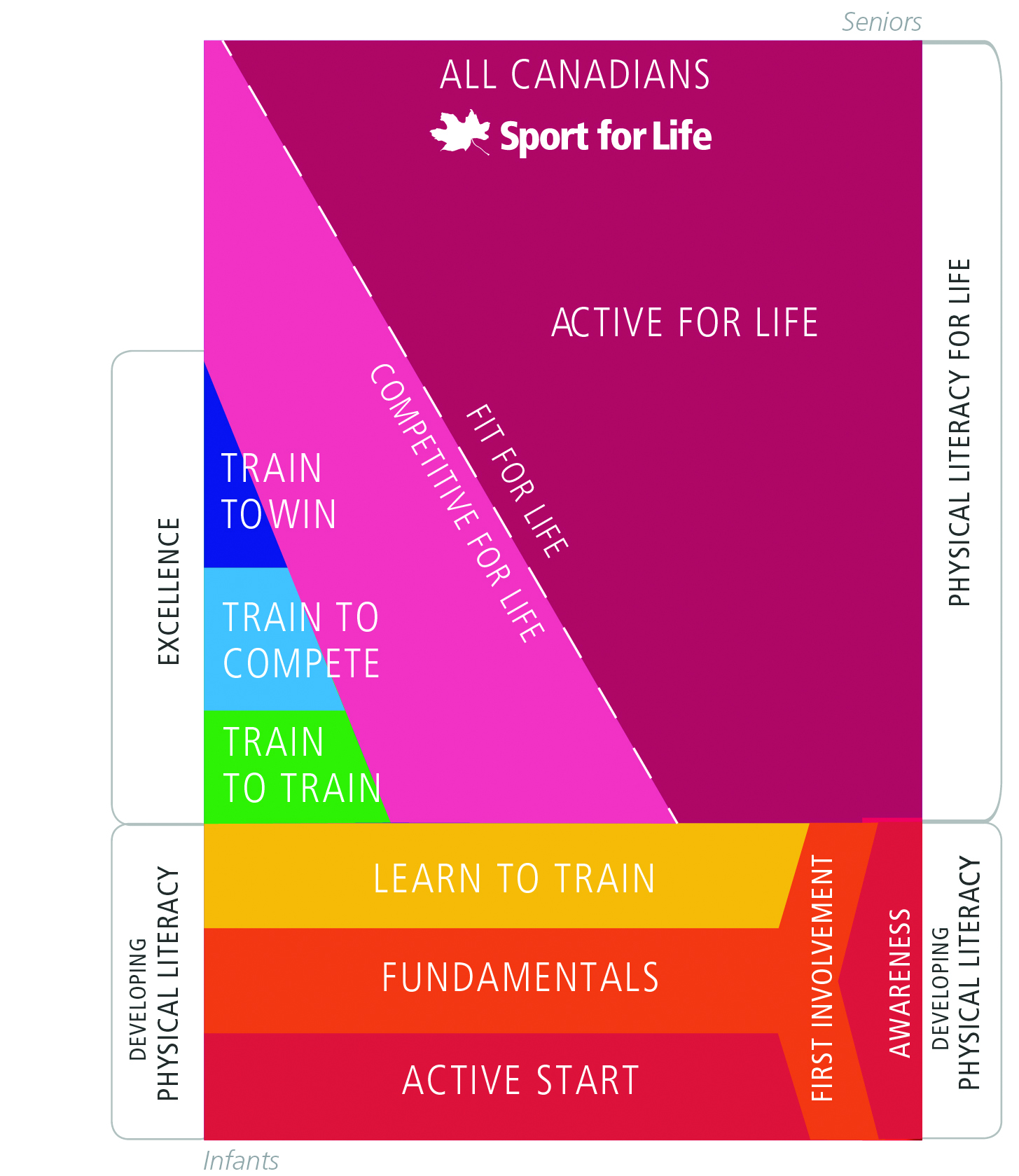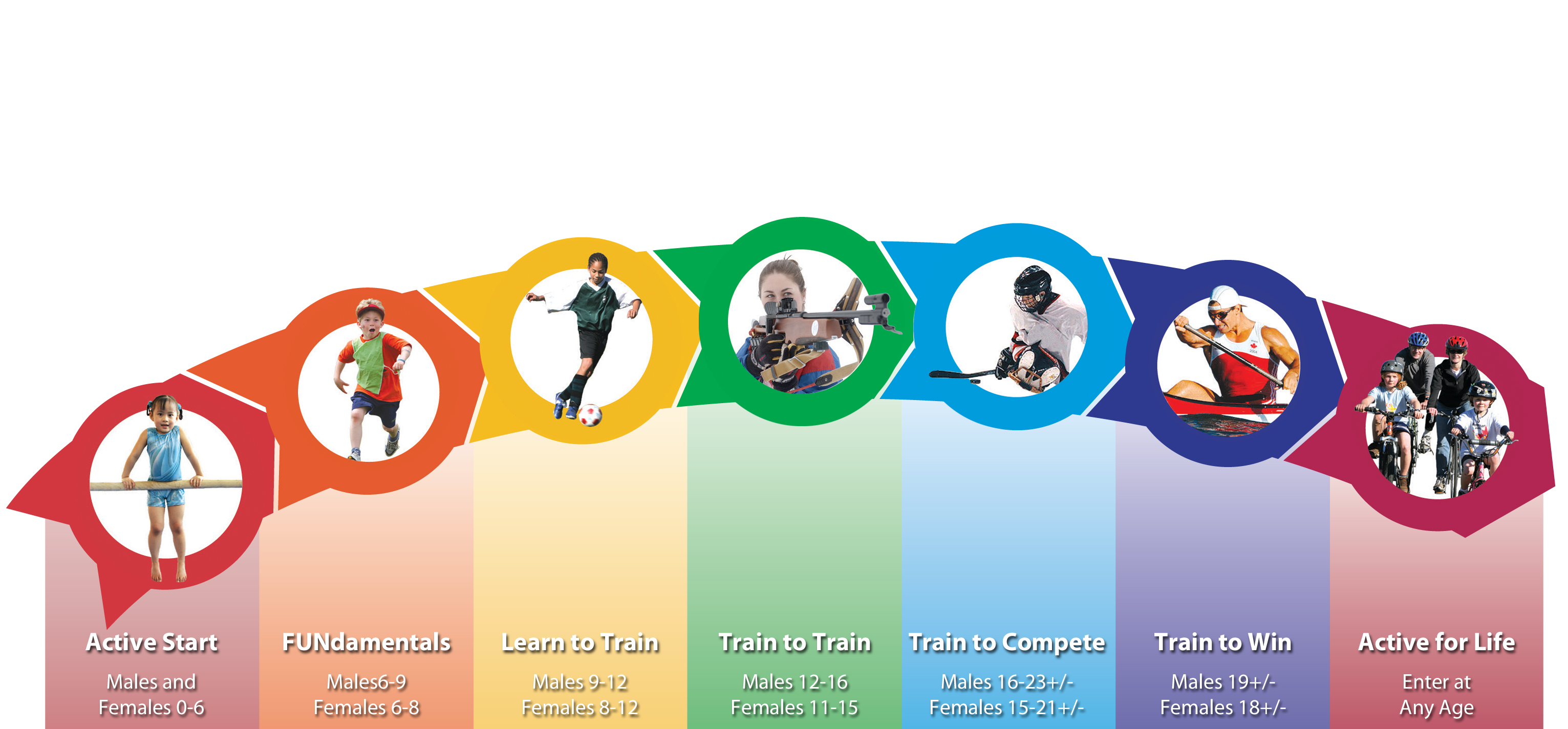LTAD: Long Term Athlete Development
Background
The Valley Royals’ primary goal is to instill in our athletes a love of being physically active, one that they will carry with them throughout their lives. In this regard, the fact that we are a track and field club is incidental. It would be the same if we were a swim club, a tennis club or a gymnastics club. It’s this love of being physically active, not the love of winning, that lays the foundation for long-term success in track and field or any other sport. This is why the Valley Royals adhere to the principles of long-term athlete development as laid out by Canada Sport for Life and adopted by Athletics Canada.
What is Long-Term Athlete Development (LTAD) and why is it important?
In order for any athlete to achieve their full potential in a given sport, he or she needs to do the right things at the right stages of their physical and mental development. Based on decades of experience, research and science, long-term athlete development provides a plan as to what these right things are and are not.
In short, LTAD:
-provides a framework for training athletes of all ages and abilities
-emphasizes fun and participation in a variety of sports and activities, particularly for younger athletes
-recognizes that athletes are individuals with different needs
-gives guidelines as to when and how athletes can begin to specialize on specific sports or events.
-encourages consistent physical activity throughout all stages of life
Sources:
All athletes and parents are encouraged to further familiarize themselves with Canada Sport for Life and long-term athlete development. Please refer to the following links:
Canada Sport for Life: https://sportforlife.ca/
Summary of LTAD: https://sportforlife.ca/long-term-development/
LTAD in Detail: http://sportforlife.ca/wp-content/uploads/2017/04/LTAD-2.1-EN_web.pdf?x96000
Athlete Pathways
What are Athlete Pathways?
Athlete pathways plan out how and when an athlete progresses from one training group to the next. With LTAD as our background, the Valley Royals have their training groups organized as follows:
Track Rascals: Ages 6-8
LTAD Framework Segments: Active Start / FUNdamentals
Description:
Athletes in Track Rascals are exposed to the very basics of track and field – simple running, jumping and throwing in a fun environment. Track Rascals typically do not compete at all but rather focus on the fun of training and trying new things. This segment lasts for 8 weeks only. All athletes are encouraged to otherwise be as active as possible in a wide variety of other sports and activities throughout the year.
Junior Development: Ages 9-13
LTAD Framework Segments: FUNdamentals / Learn to Train
Description:
Junior Development athletes further develop fundamental skills in running (both short and long), hurdles, throws and jumps in a fun environment. Although athletes in this stage may show talent in some events more than others, emphasis remains on learning and developing skills in a wide variety of events. Although there are several competitions, more emphasis is placed on training, rather than on competing. The JD track and field season typically starts in early April and runs through to mid to late July. All athletes are encouraged to otherwise be as active as possible in a wide variety of other sports and activities throughout the year.
Senior Groups: Power/Speed (Sprints, Hurdles and Jumps), Throws, Distance
Ages 14+ (Masters Athletes included)
LTAD Framework Segments: Train to Train / Train to Compete, Train to Win and Active for Life
Description:
Athletes in the senior groups further develop their major components of fitness and event-specific skills. Athletes may, if they choose, and if the coach deems it appropriate to do so, begin to specialize in a particular event or event group at this stage. Athletes at this stage may train with more than one group with guidance from their coaches. Although training for these groups is typically offered for most of the year, it is not a requirement for athletes. Even though athletes in this stage may be more focused on specific event(s) they are still encouraged to continue to participate in other sports or activities.
Notes about Valley Royals Athlete Pathways:
We recommend that all athletes, of all ages and in all stages, maintain a balance in their training. Participating in other sports or activities (be they organized or not) helps to prevent injury and/or mental/physical burnout. This is particularly important for younger athletes. Generally, the greater the variety of sports or activities that a young athlete has the opportunity participate in, the better off they will be in long-term. This exposure to a variety of sports gives kids foundational skills that carry over to whatever sport(s) they may decide to focus on later in life.
An athlete’s chronological age tells us which training group an athlete should be training with, nothing more. Typically, these guidelines are in place to group athletes together with the same levels of mental and emotional maturity more so than physical maturity. Within a given group, it’s the athlete’s physical, emotional and mental maturity, the athlete’s desires, goals and long-term best interests, not their chronological age, that determines an athlete’s specific training needs.
Written by: Valley Royals Head Coach, Trevor Wight
Page Created March 31st, 2020


